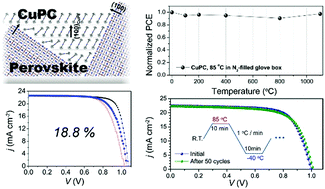Engineering interface structures between lead halide perovskite and copper phthalocyanine for efficient and stable perovskite solar cells†
Abstract
Successful commercialization of perovskite solar cells (PSCs) in the near future will require the fabrication of cells with high efficiency and long-term stability. Despite their good processability at low temperatures, the majority of organic conductors employed in the fabrication of high-efficiency PSCs [e.g., 2,2′,7,7′-tetrakis(N,N-di-p-methoxyphenylamine)-9,9′-spirobifluorene (spiro-OMeTAD) and poly(triaryl amine) (PTAA)] have low thermal stability. In order to fabricate PSCs with excellent thermal stability, both the constituent material itself and the interface between the constituents must be thermally stable. In this work, we focused on copper phthalocyanine (CuPC) as a model hole-transporting material (HTM) for thermally stable PSCs since CuPC is known to possess excellent thermal stability and interfacial bonding properties. The CuPC-based PSCs recorded a high power conversion efficiency (PCE) of ∼18% and maintained 97% of their initial efficiency for more than 1000 h of thermal annealing at 85 °C. Moreover, the device was stable under thermal cycling tests (50 cycles, −45 to 85 °C). The high PCE and high thermal stability observed in the CuPC-PSCs were found to arise as a result of the strong interfacial and conformal coating present on the surface of the perovskite facets, located between CuPC and the perovskite layer. These results will provide an important future direction for the development of highly efficient and thermally stable PSCs.



 Please wait while we load your content...
Please wait while we load your content...